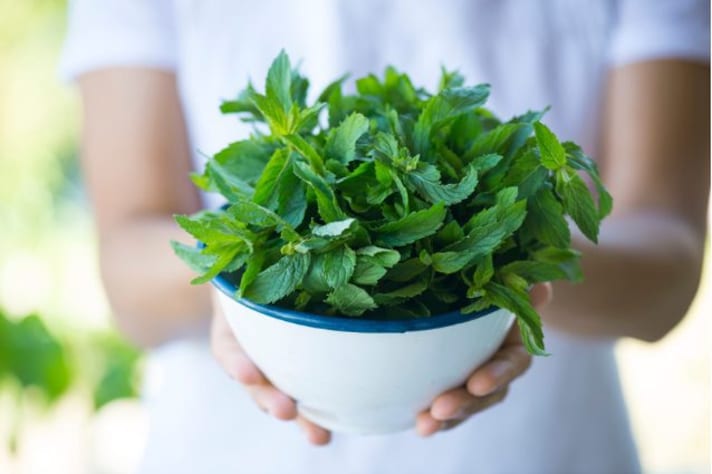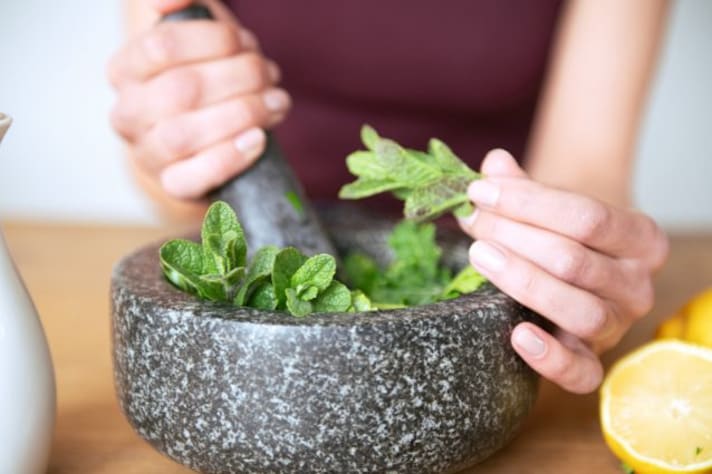Here’s Why You Should Never Throw Away Mint Stems After Using the Leaves
Most people toss mint stems without a second thought, but they’re actually packed with flavor and just as useful as the leaves. From infusing syrups and cocktails to adding depth to broths and pestos, these overlooked stems have plenty of culinary potential. Whether steeped, muddled, or grilled, they bring a fresh twist to dishes while cutting down on food waste—making them worth saving every time.

Mint is a kitchen staple, whether it’s brightening up a cocktail, adding freshness to a salad, or starring in a dessert. But most of us make the same mistake: plucking the fragrant leaves and tossing the stems straight into the trash. It’s an easy habit, but one that’s wasting an entire layer of minty potential. The truth is, those stems are just as useful—sometimes even more—than the delicate leaves we prize. It’s time to rethink the way we use mint from stem to tip.
A Hidden Source of Flavor
If you’ve ever handled fresh mint, you know the stems smell just as strong—if not stronger—than the leaves themselves. That’s because mint stems are packed with essential oils, the compounds responsible for the herb’s signature cool, tingling effect. While the stems might be a little tougher in texture, they still hold a punch of pure mint flavor that can be extracted in ways the leaves simply can’t handle. Instead of wasting all that herbal goodness, the trick is knowing how to use them wisely.
Steeping and Infusions: The Easy Route to Extracting Flavor
One of the simplest ways to make use of mint stems is to steep them. Unlike the leaves, which can turn bitter if oversteeped, the stems hold up beautifully in hot water, syrups, and even alcohol infusions. Toss them into a pot for a fragrant herbal tea, let them simmer in simple syrup for homemade mint syrup, or drop them into a bottle of vodka for a naturally flavored spirit. The stems release their essence gradually, delivering a subtle, well-rounded mintiness without the risk of overwhelming bitterness.

A Secret Weapon for Stocks and Broths
Herb stems are a well-kept chef’s secret when it comes to building deep, aromatic broths—and mint is no exception. While you might not think of mint as a go-to ingredient for stocks, its cooling, slightly sweet flavor can bring a surprising freshness to vegetable broths, lamb or chicken stocks, and even pho-inspired soups. Add the stems in whole and let them simmer with the other aromatics, then strain them out before serving. The result? A subtle depth of flavor that doesn’t scream "mint" but adds an unmistakable brightness.
A New Take on Pesto and Herb Pastes
If you’re already blending up mint for a sauce, why not throw in the stems too? While they might not be as tender as the leaves, they break down just fine in a food processor. Using the stems in a mint pesto, chimichurri, or herb chutney not only stretches your ingredients further but also intensifies the herbal flavor. Just make sure to remove any super-woody sections and blend them well for a smooth consistency.

Cocktails That Pack a Punch
Mojito lovers, take note: those mint stems you’ve been tossing? They actually make an excellent muddling ingredient. In fact, bartenders often prefer stems over leaves because they hold up better under pressure—literally. Muddling mint leaves too aggressively can turn them bitter, while stems release their oils without breaking down as quickly. Whether you’re mixing up a mojito, a julep, or a refreshing mint lemonade, save the stems for the muddler and let the leaves shine as garnish.
A Fresh Addition to Roasted and Grilled Dishes
Mint isn’t just for drinks and desserts—it plays beautifully with savory dishes, especially those involving fire and smoke. Whole mint stems can be tossed directly onto a grill to perfume meats and vegetables with a subtle mint aroma. Alternatively, they can be finely chopped and mixed into marinades for lamb, chicken, or even roasted eggplant. The high oil content in the stems helps distribute that fresh, herbal essence throughout the dish, making it more complex and aromatic.
;Resize,width=767;)



